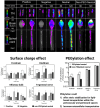Recent Advances in Intranasal Administration for Brain-Targeting Delivery: A Comprehensive Review of Lipid-Based Nanoparticles and Stimuli-Responsive Gel Formulations
- PMID: 38414526
- PMCID: PMC10898487
- DOI: 10.2147/IJN.S439181
Recent Advances in Intranasal Administration for Brain-Targeting Delivery: A Comprehensive Review of Lipid-Based Nanoparticles and Stimuli-Responsive Gel Formulations
Abstract
Addressing disorders related to the central nervous system (CNS) remains a complex challenge because of the presence of the blood-brain barrier (BBB), which restricts the entry of external substances into the brain tissue. Consequently, finding ways to overcome the limited therapeutic effect imposed by the BBB has become a central goal in advancing delivery systems targeted to the brain. In this context, the intranasal route has emerged as a promising solution for delivering treatments directly from the nose to the brain through the olfactory and trigeminal nerve pathways and thus, bypassing the BBB. The use of lipid-based nanoparticles, including nano/microemulsions, liposomes, solid lipid nanoparticles, and nanostructured lipid carriers, has shown promise in enhancing the efficiency of nose-to-brain delivery. These nanoparticles facilitate drug absorption from the nasal membrane. Additionally, the in situ gel (ISG) system has gained attention owing to its ability to extend the retention time of administered formulations within the nasal cavity. When combined with lipid-based nanoparticles, the ISG system creates a synergistic effect, further enhancing the overall effectiveness of brain-targeted delivery strategies. This comprehensive review provides a thorough investigation of intranasal administration. It delves into the strengths and limitations of this specific delivery route by considering the anatomical complexities and influential factors that play a role during dosing. Furthermore, this study introduces strategic approaches for incorporating nanoparticles and ISG delivery within the framework of intranasal applications. Finally, the review provides recent information on approved products and the clinical trial status of products related to intranasal administration, along with the inclusion of quality-by-design-related insights.
Keywords: bypassing BBB; in situ gel; lipid based nanoparticle; nose to brain delivery system.
© 2024 Koo et al.
Conflict of interest statement
The authors declare that they have no conflicts of interest in this work.
Figures









Similar articles
-
Nose to Brain: Exploring the Progress of Intranasal Delivery of Solid Lipid Nanoparticles and Nanostructured Lipid Carriers.Int J Nanomedicine. 2024 Nov 21;19:12343-12368. doi: 10.2147/IJN.S497480. eCollection 2024. Int J Nanomedicine. 2024. PMID: 39606563 Free PMC article. Review.
-
Convolutions in the rendition of nose to brain therapeutics from bench to bedside: Feats & fallacies.J Control Release. 2022 Jan;341:782-811. doi: 10.1016/j.jconrel.2021.12.009. Epub 2021 Dec 11. J Control Release. 2022. PMID: 34906605 Review.
-
Non-Invasive Techniques of Nose to Brain Delivery Using Nanoparticulate Carriers: Hopes and Hurdles.AAPS PharmSciTech. 2024 Oct 30;25(8):256. doi: 10.1208/s12249-024-02946-z. AAPS PharmSciTech. 2024. PMID: 39477829 Review.
-
Drug Delivery and Targeting to the Brain Through Nasal Route: Mechanisms, Applications and Challenges.Curr Drug Deliv. 2019;16(10):887-901. doi: 10.2174/1567201816666191029122740. Curr Drug Deliv. 2019. PMID: 31660815 Review.
-
Lipid nanoparticles strategies to modify pharmacokinetics of central nervous system targeting drugs: Crossing or circumventing the blood-brain barrier (BBB) to manage neurological disorders.Adv Drug Deliv Rev. 2022 Oct;189:114485. doi: 10.1016/j.addr.2022.114485. Epub 2022 Aug 12. Adv Drug Deliv Rev. 2022. PMID: 35970274 Review.
Cited by
-
Focused ultrasound on the substantia nigra enables safe neurotensin-polyplex nanoparticle-mediated gene delivery to dopaminergic neurons intranasally and by blood circulation.Discov Nano. 2024 Apr 2;19(1):60. doi: 10.1186/s11671-024-04005-9. Discov Nano. 2024. PMID: 38564106 Free PMC article.
-
Intranasal Drug Delivery Technology in the Treatment of Central Nervous System Diseases: Challenges, Advances, and Future Research Directions.Pharmaceutics. 2025 Jun 13;17(6):775. doi: 10.3390/pharmaceutics17060775. Pharmaceutics. 2025. PMID: 40574087 Free PMC article. Review.
-
Nasal Delivery to the Brain: Harnessing Nanoparticles for Effective Drug Transport.Pharmaceutics. 2024 Apr 1;16(4):481. doi: 10.3390/pharmaceutics16040481. Pharmaceutics. 2024. PMID: 38675142 Free PMC article. Review.
-
In-depth Mechanism, Challenges, and Opportunities of Delivering Therapeutics in Brain Using Intranasal Route.AAPS PharmSciTech. 2024 May 6;25(5):96. doi: 10.1208/s12249-024-02810-0. AAPS PharmSciTech. 2024. PMID: 38710855 Review.
-
Nanotechnological approaches for efficient N2B delivery: from small-molecule drugs to biopharmaceuticals.Beilstein J Nanotechnol. 2024 Nov 12;15:1400-1414. doi: 10.3762/bjnano.15.113. eCollection 2024. Beilstein J Nanotechnol. 2024. PMID: 39559726 Free PMC article. Review.
References
Publication types
MeSH terms
Substances
LinkOut - more resources
Full Text Sources

